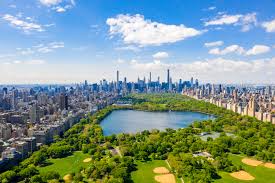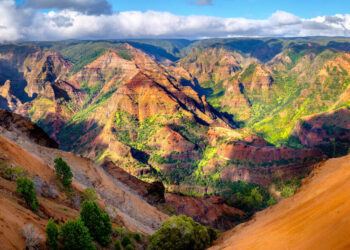Amid the relentless rhythm of Manhattan lies Central Park, a sprawling 843-acre sanctuary where skyscrapers yield to ancient oaks, car horns fade into birdsong, and the city’s chaos softens into serenity. Designed as a democratic escape for all, the park stitches together meadows, lakes, and wooded trails, offering New Yorkers and visitors alike a respite from concrete and screens.
Whether you’re rowing across the glassy surface of The Lake, picnicking beneath the elms of Sheep Meadow, or tracing the curves of its storied bridges, Central Park transcends mere greenery—it’s a living tapestry of art, history, and nature, woven into the heart of the world’s most unforgiving city.
Fun Fact: Central Park is entirely man-made. Built between 1858 and 1876, its creators—Frederick Law Olmsted and Calvert Vaux—transformed swamps, rocky outcrops, and pig farms into a meticulously engineered Eden. Over 20,000 workers moved nearly 5 million cubic yards of soil and stone to sculpt its landscapes. Even the “natural” boulders dotting the park? Many were buried glacial relics uncovered during construction.
How to Get There
By Air
New York’s three major airports—JFK, LaGuardia, and Newark Liberty—connect Central Park to the globe. From JFK, the AirTrain links to the E subway line (transfer at 42nd Street-Port Authority for the C or B trains to 72nd or 81st Streets). LaGuardia offers quicker access: take the M60 bus to Harlem-125th Street, then the 2/3 subway south to Central Park North. Rideshares cost 35–50 from JFK, but traffic can double travel time—opt for the subway during peak hours.
By Subway
Central Park is bordered by four subway lines:
West Side: 1/2/3 (Columbus Circle/59th St) or B/C (72nd, 81st, 86th Sts).
East Side: 4/5/6 (59th, 68th, 77th, 86th, 96th Sts).
Central Park North: 2/3 (110th St) or A/B/C/D (125th St).
Exit at 72nd Street-Central Park West for instant access to Strawberry Fields or Bethesda Terrace.
On Foot
From Midtown landmarks:
Times Square: 15-minute walk east to Sixth Avenue, then north to 59th Street entrance.
Fifth Avenue Museums: Stroll west from the Met or Guggenheim directly into the park’s East Drive.
Avoid driving—parking is scarce and metered spots cost upwards of 7/hour(4.49/day plus usage fees) from stations along the park’s periphery.
Things to Do in Central Park
Bethesda Terrace & Fountain
The park’s architectural soul, this neo-classical terrace overlooks The Lake, anchored by the Angel of the Waters statue. Beneath the terrace, the arcade’s ceiling bursts with 15,000 intricate Minton tiles—a Victorian masterpiece. Arrive at dawn to hear street musicians echo under the vaults, or join sunset crowds clinking wine glasses on the steps.
The Ramble
A 38-acre woodland dubbed “the Wild Garden,” this maze of trails and streams is a birder’s haven. Spy warblers, woodpeckers, and the occasional red-tailed hawk. Follow the Bank Rock Bridge to hidden glens, but keep a map handy—it’s easy to lose yourself here (intentionally or not).
Central Park Zoo
Compact yet charming, this zoo houses snow leopards, grizzly bears, and a tropical rainforest dome. Don’t miss the Penguin House or the sea lion feedings at 11:30 AM and 2:30 PM. Adjacent Tisch Children’s Zoo lets kids groom alpacas or clamber into a turtle shell.
Belvedere Castle
Perched atop Vista Rock, this 1869 folly offers panoramic views of Turtle Pond and the Great Lawn. Inside, the Henry Luce Nature Observatory loans binoculars and guides for spotting migrating monarchs or Orion’s Belt over the Delacorte Theater.
Bow Bridge
A cast-iron icon spanning The Lake, this lace-like bridge frames postcard views of the Upper West Side. Rent a rowboat ($20/hour) from Loeb Boathouse and paddle beneath its arches—spring brings cherry blossoms, while fall sets the water ablaze with reflected foliage.
Seasonal Highlights
Winter: Skate under the skyline at Wollman Rink (rentals 27–35).
Summer: Catch free Shakespeare in the Park performances at the Delacorte.
Fall: Walk the Mall’s elm canopy as leaves crunch gold underfoot.
Central Park’s Evolution: From Grit to Glory
Central Park’s story mirrors New York’s own. Conceived during the 1850s as a rebuttal to urban squalor, its construction displaced 1,600 mostly Black and Irish residents of Seneca Village—a thriving community erased for “progress.” The park later hosted Civil War drills, Depression-era soup lines, and 1960s protest rallies. By the 1970s, neglect left it littered with debris and crime. Revival came in the 1980s via the Central Park Conservancy, which restored its grandeur through private funding. Today, its 42 million annual visitors tread paths once walked by carriage horses and suffragettes.
Where to Stay
The Plaza Hotel
Opulence meets park views. Overlooking Grand Army Plaza, this 1907 landmark offers gilded suites and afternoon tea in the Palm Court. For a splurge, book the Eloise Suite, a pink explosion honoring the fictional child who “lived” here.
Loeb Boathouse Central Park
Mid-range charm with lakeside access. The adjacent Boathouse Hotel offers rustic-chic rooms and private terraces. Kayak at sunrise, then breakfast on blueberry pancakes at the restaurant.
Jazz on Columbus Circle
Budget-friendly and vibrant, this hostel-style hotel near the park’s southwest corner mixes dorm beds and private rooms. The rooftop lounge hosts live jazz nights with skyline vistas.
Central Park Eats
Tavern on the Green
Revived from its 1930s roots, this landmark serves Hudson Valley duck breast and truffle fries in a crystal-chandeliered dining room. Reserve weeks ahead for brunch on the garden patio.
Le Pain Quotidien
Fuel hikes with organic avocado toast or Belgian waffles at this cozy café near the Mineral Springs Pavilion. Grab a tartine and latte to-go for a Bench Society picnic.
Hot Dog Cart
No park visit is complete without a street vendor’s $3 hot dog—smothered in kraut and mustard—eaten while people-watching on Conservatory Water’s benches.
Wrapping Up
Central Park is more than a park—it’s New York’s communal backyard, a stage for solitude and spectacle alike. Its genius lies in balance: wildflower meadows contrast with precision-cut gardens, quiet trails coexist with bustling plazas, and centuries-old design still feels timeless. Whether you’re jogging the Reservoir at dawn, tracing the whispers of Seneca Village, or simply lying in Sheep Meadow’s grass, the park invites you to pause, breathe, and remember that even in a city of steel, nature holds its ground. Come for the landmarks, stay for the quiet moments—the way light filters through oak leaves, the laughter echoing off Bethesda’s tiles, the certainty that somewhere in these 843 acres, New York feels exactly as it should.











